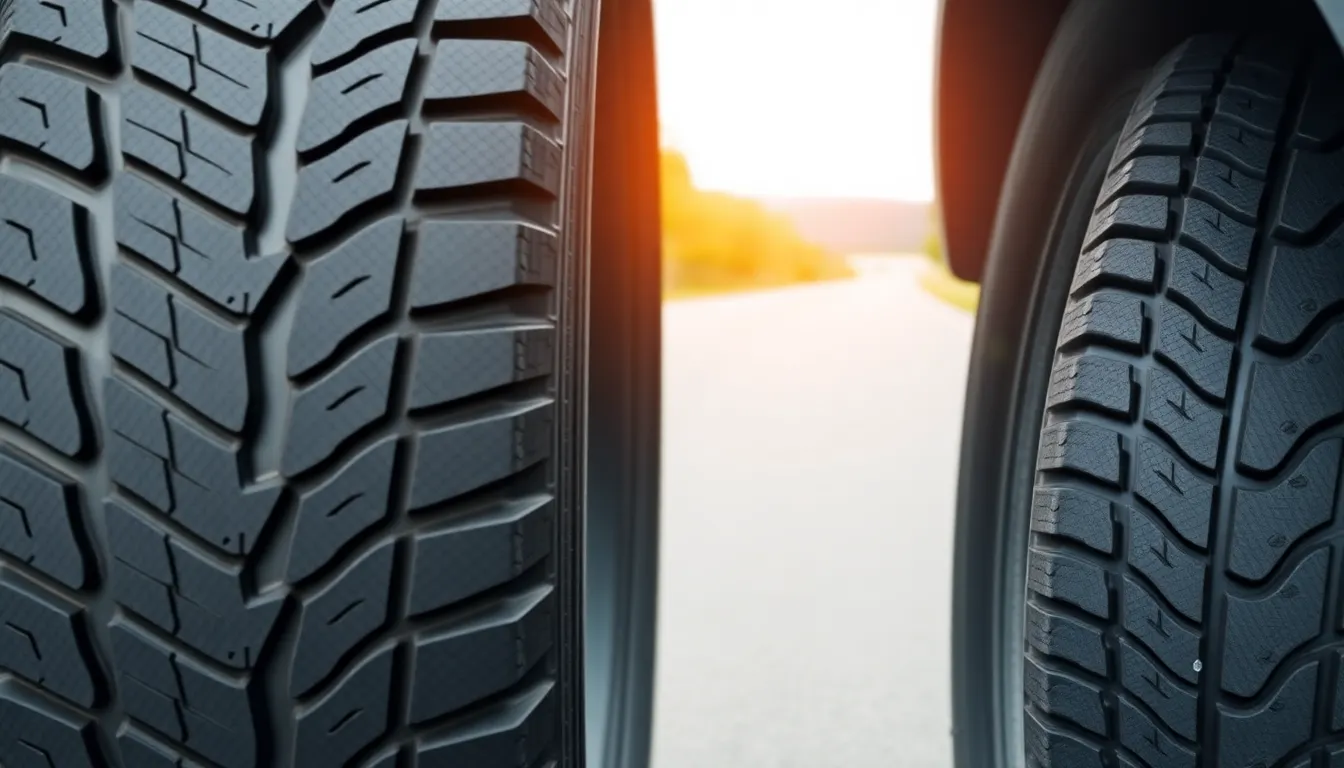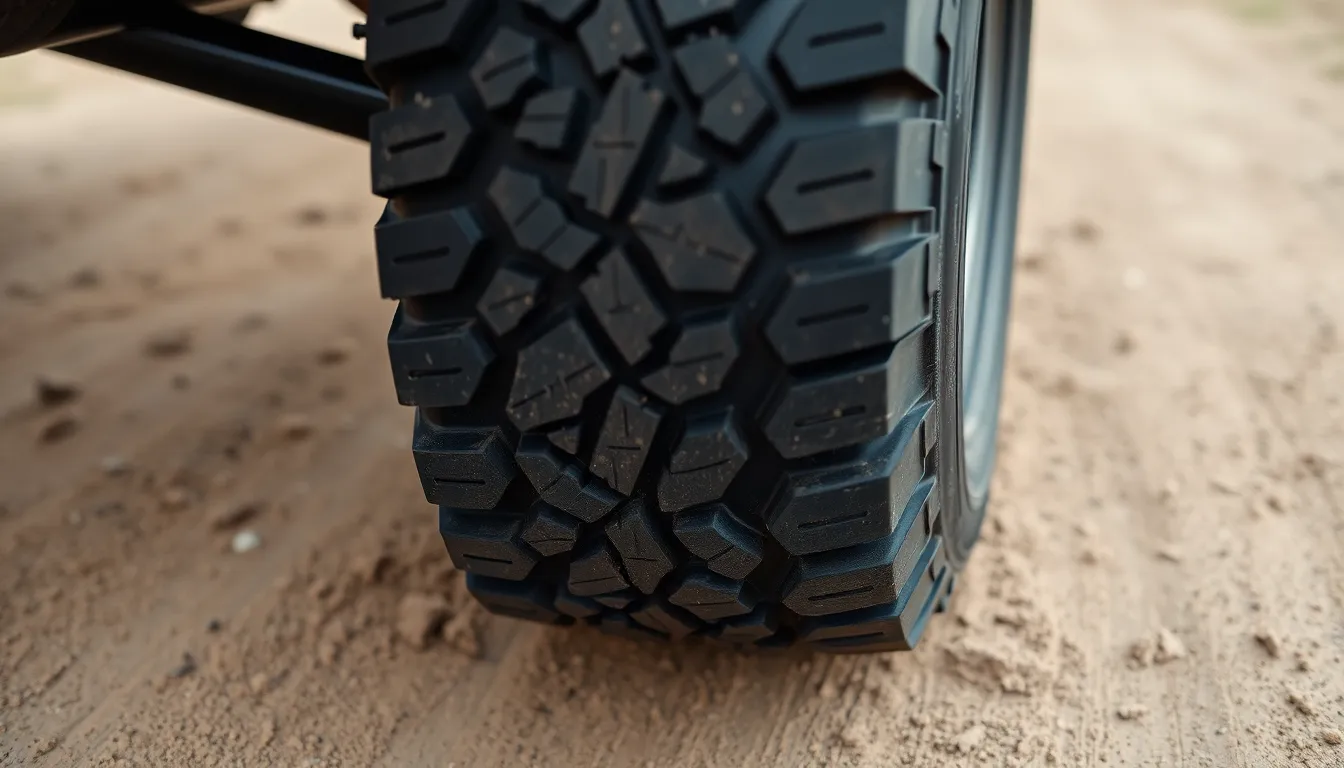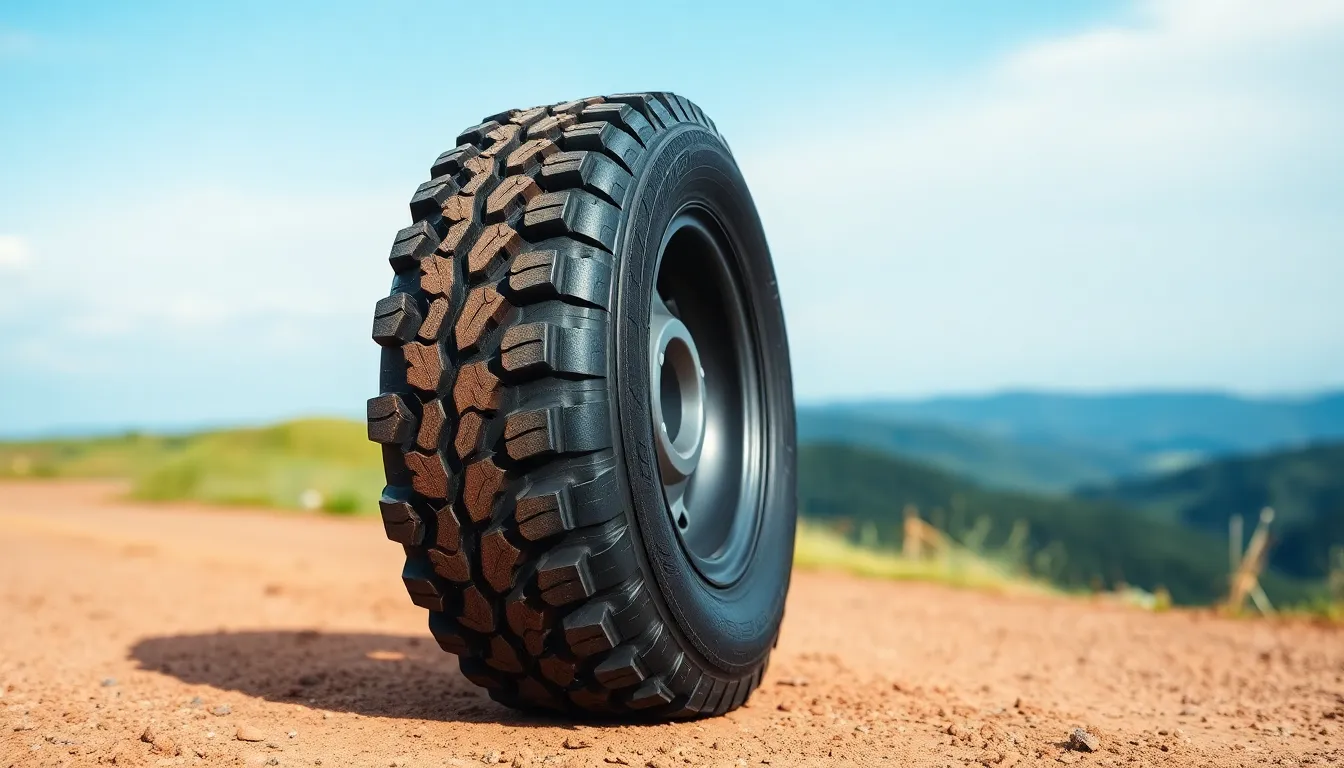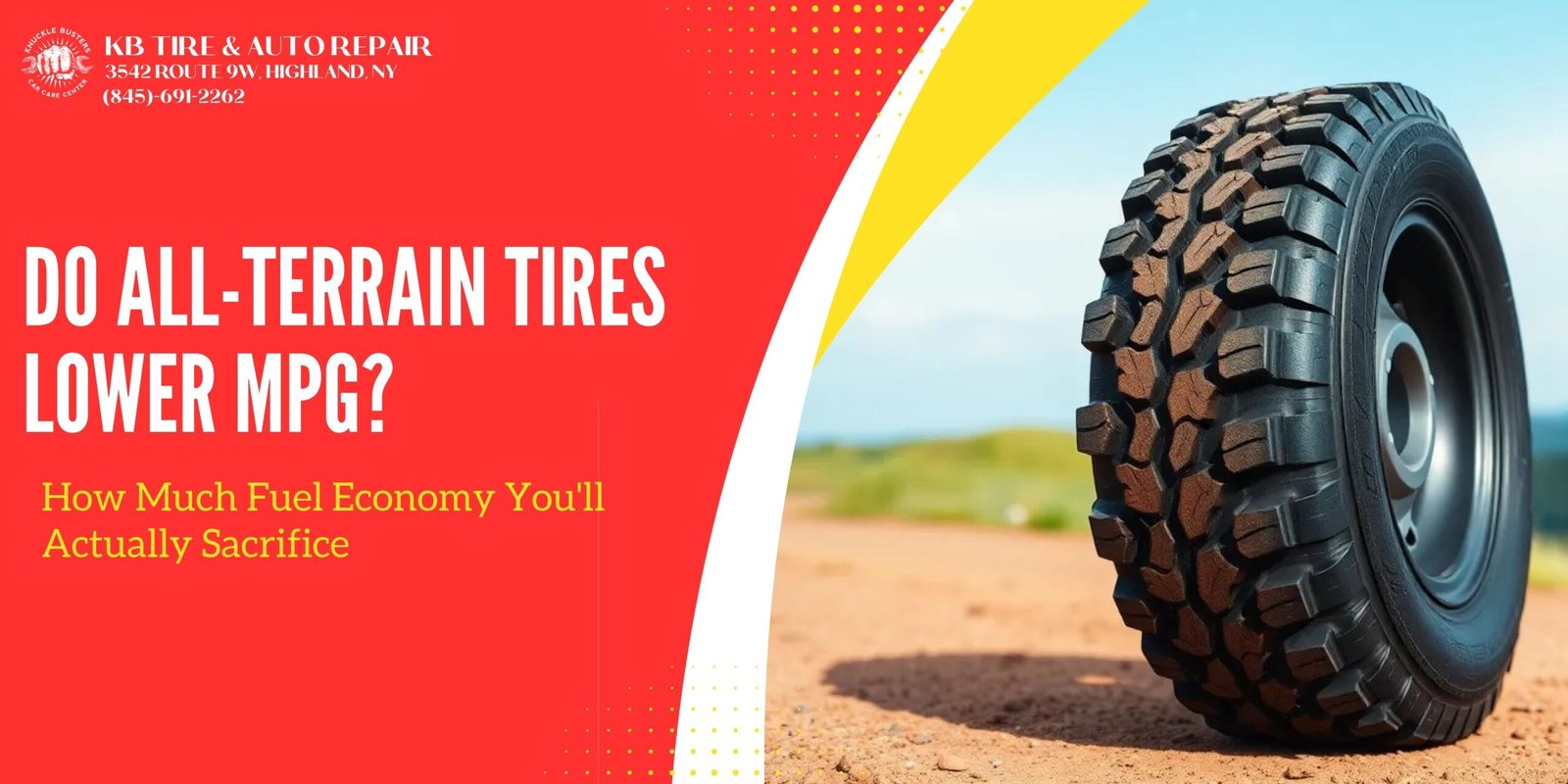Wondering if those rugged all-terrain tires will drain your gas tank faster? You’re not alone. Many drivers face this dilemma when considering upgrading their vehicle’s footwear for off-road adventures.
The short answer is yes—all-terrain tires do impact your fuel economy. Data shows they can reduce gas mileage by approximately 3-5% for passenger cars and up to 5-10% for trucks, which translates to losing 1-3 mpg compared to standard highway tires. This difference stems from their larger diameter, deeper tread patterns, and increased rolling resistance that forces your engine to work harder on every journey.
Before you dismiss all-terrain tires completely, it’s worth understanding the trade-offs. While they might cost you at the pump, they deliver superior performance across varied road conditions including mud, snow, sand, and unpaved surfaces—versatility that standard tires simply can’t match.
Understanding All-Terrain Tires
All-terrain tires are specialized automotive components designed to handle a variety of road conditions beyond just paved surfaces. These versatile tires balance on-road comfort with off-road capability, making them popular choices for adventure-seeking drivers who don’t want to sacrifice everyday drivability.
What Makes Them Different From Highway Tires
All-terrain tires feature several distinctive design elements that set them apart from standard highway tires. The most noticeable difference is the tread pattern – all-terrain tires have deeper grooves and more open patterns specifically engineered for enhanced traction on varied surfaces. This aggressive tread design helps these tires grip effectively in mud, snow, sand, and rocky terrain.
The construction of all-terrain tires is typically more rugged and heavier than highway tires. They’re built with reinforced sidewalls to withstand punctures and damage when driving off-road. This sturdier build contributes to their increased weight, which is one factor that affects their fuel efficiency.
Highway tires, in contrast, feature smoother tread patterns optimized for paved roads. These designs minimize rolling resistance – the energy a vehicle must expend to keep the tires moving forward. Lower rolling resistance translates directly to better fuel economy, which is why highway tires generally offer better MPG performance than their all-terrain counterparts.
The performance difference is measurable – all-terrain tires typically reduce fuel economy by about 3% compared to highway tires. For many drivers, this trade-off is acceptable given the versatility all-terrain tires provide across multiple driving conditions and terrains.
Modern all-terrain tire manufacturers have made significant advancements in reducing this efficiency gap through innovations in rubber compounds and tread designs that maintain off-road capability while minimizing the impact on fuel consumption.
How All-Terrain Tires Impact Fuel Economy

All-terrain tires affect your vehicle’s fuel efficiency through multiple mechanisms. The design elements that make these tires excellent for off-road driving simultaneously contribute to increased fuel consumption compared to standard highway tires.
The Science of Rolling Resistance
Rolling resistance directly impacts how much fuel your vehicle consumes. All-terrain tires create higher rolling resistance than highway tires due to their construction and materials. This resistance occurs as the tire deforms against the road surface, requiring your engine to work harder to maintain speed. The heavier build of all-terrain tires, designed to withstand the demands of off-road use, increases this resistance significantly. With all-terrain tires, passenger cars typically experience a 3-5% decrease in fuel efficiency, while trucks may see a more substantial 5-10% reduction, translating to 1-3 fewer miles per gallon compared to highway tires.
Tread Pattern and Its Effect on MPG
The tread design of all-terrain tires significantly influences their impact on MPG. All-terrain tires feature:
- Deeper grooves that increase air resistance when driving
- Open tread patterns that grip uneven terrain but reduce aerodynamic efficiency
- Rigid tread blocks that add weight and rolling resistance
- Staggered step-down grooves for stability that affect tire-road contact
These aggressive tread patterns grip both pavement and off-road surfaces effectively but come with an efficiency cost. The deeper and more open tread designs disturb airflow around the tire, creating drag that your engine must overcome. Modern all-terrain tire manufacturers have begun addressing this issue by developing tread patterns that balance off-road capability with reduced rolling resistance, minimizing the MPG reduction while maintaining the versatility that makes these tires appealing. Despite innovations, all-terrain tires still lower MPG compared to highway options, though they remain more fuel-efficient than specialized mud-terrain tires.
Comparing MPG: All-Terrain vs. Standard Tires

All-terrain tires and standard highway tires offer different performance benefits depending on your driving needs. The fuel efficiency difference between these tire types is significant and directly impacts your vehicle’s operating costs.
Real-World Fuel Economy Data
All-terrain tires do lower MPG compared to standard highway tires, with real-world data showing an average decrease in fuel economy of approximately 3%. This translates to a reduction of up to two miles per gallon in many vehicles. Highway tires, designed specifically for paved surfaces, feature simpler tread patterns that create less rolling resistance, allowing them to improve fuel efficiency by 4-6% compared to their all-terrain counterparts.
The impact varies by vehicle type and driving conditions:
| Tire Type | Average MPG Impact | Fuel Economy Rating |
|---|---|---|
| Highway Tires | +4-6% improvement | A (typically) |
| All-Terrain Tires | -3% decrease | Lower than highway |
| Mud-Terrain Tires | Greater decrease than all-terrain | Lowest rating |
When comparing performance on paved roads, highway tires maintain better efficiency at higher speeds. All-terrain tires’ deeper treads create more drag on highways, requiring your engine to work harder and consume more fuel. This effect is particularly noticeable during interstate driving where the speed and distance amplify the fuel consumption difference.
For everyday drivers who occasionally venture off-road, the 1-2 MPG difference might be an acceptable trade-off for the versatility all-terrain tires provide. However, if you’re primarily driving on paved roads and fuel economy is a priority, standard highway tires offer clear advantages in terms of gas mileage and long-term fuel costs.
Manufacturers continue developing technology to narrow this efficiency gap, with newer all-terrain tire models featuring advanced compounds and optimized tread designs that maintain off-road capability while minimizing their impact on your vehicle’s fuel consumption.
Factors Affecting Fuel Efficiency With All-Terrain Tires

All-terrain tires lower MPG through several key mechanisms that affect your vehicle’s fuel consumption. Understanding these factors helps you make informed decisions about tire selection and maintenance to minimize the impact on your gas mileage.
Tire Size and Weight
All-terrain tires typically weigh 10-15% more than standard highway tires due to their robust construction. This additional weight requires more energy to rotate, directly increasing fuel consumption. Larger all-terrain tires compound this effect—each inch of increased diameter can reduce fuel efficiency by approximately 1-2%.
The heavier construction includes reinforced sidewalls and durable rubber compounds designed to withstand off-road hazards like sharp rocks and branches. These protective features add significant mass compared to highway tires, forcing your engine to work harder during acceleration and maintaining speed.
Oversized all-terrain tires further impact fuel economy by altering your vehicle’s gear ratios. When tire diameter increases without corresponding drivetrain modifications, your engine operates outside its optimal efficiency range, leading to increased fuel consumption during normal driving conditions.
Proper Inflation and Maintenance
Maintaining correct tire pressure is critical for maximizing fuel efficiency with all-terrain tires. Underinflated tires increase rolling resistance by 10-20%, dramatically reducing MPG. All-terrain tires require precise inflation as their stiffer sidewalls and thicker tread make detecting underinflation by visual inspection difficult.
Regular tire rotation every 5,000-8,000 miles ensures even tread wear across all four tires, preserving proper contact patterns with the road surface. Uneven wear creates irregular contact patches that increase rolling resistance and subsequently lower fuel economy.
Wheel alignment significantly impacts how efficiently all-terrain tires roll. Misalignment as small as 0.17° increases drag forces, requiring more fuel to overcome. With all-terrain tires’ naturally higher rolling resistance, proper alignment becomes even more crucial for maintaining optimal MPG.
Tire balancing prevents vibrations that waste energy and reduces premature wear patterns that can further decrease fuel efficiency. All-terrain tires, with their heavier construction and chunky tread blocks, are particularly susceptible to imbalance issues that compound their existing fuel economy disadvantages.
Balancing Off-Road Performance and Fuel Economy

Finding the sweet spot between off-road capability and fuel efficiency isn’t impossible with all-terrain tires. Despite the fact that all-terrain tires lower MPG, manufacturers have made significant strides in developing options that minimize this compromise.
When the Trade-Off Makes Sense
All-terrain tires make perfect sense for drivers who regularly venture off the beaten path. If you’re taking your 4×4 vehicle to beaches, through snow, or across gravel roads at least monthly, the 3-5% reduction in fuel economy is a worthwhile sacrifice for the enhanced traction and safety these tires provide. The versatility of all-terrain tires becomes especially valuable in regions with varied terrain or unpredictable weather conditions, where the ability to transition seamlessly from highways to trails outweighs the modest fuel penalty.
For weekend adventurers with trucks or SUVs, modern all-terrain tires strike an increasingly favorable balance. Today’s advanced tire compounds and optimized tread designs offer improved highway performance while maintaining off-road capability. Many newer all-terrain models feature technology that reduces rolling resistance without compromising grip, resulting in fuel efficiency losses closer to 2-3% rather than the 5-10% seen with more aggressive off-road tires.
The trade-off calculation also depends on your typical driving distance. For someone with a short daily commute who lives for weekend adventures, the additional fuel costs from reduced MPG might only amount to a few dollars per month—a small price for the freedom to explore diverse terrains whenever the opportunity arises.
Tips to Maximize MPG With All-Terrain Tires

All-terrain tires do lower MPG, but you can minimize their impact on fuel efficiency through strategic choices and proper maintenance. These practical tips help you enjoy the versatility of all-terrain tires while keeping fuel consumption in check.
Choose the Right Tire Size
Sticking to manufacturer-recommended tire sizes optimizes your vehicle’s fuel economy. Oversized all-terrain tires might look impressive and perform well off-road, but they significantly increase rolling resistance and weight. This forces your engine to work harder, consuming more fuel. The manufacturer’s specifications ensure your powertrain and gearing remain optimized for the best possible MPG performance.
Invest in Advanced Tire Technology
Modern all-terrain tires feature innovative designs that balance off-road capability with fuel efficiency. Manufacturers now produce all-terrain options with:
- Lighter materials reducing overall weight
- Low rolling resistance compounds
- Optimized tread patterns that maintain traction while minimizing drag
- Advanced rubber formulations that stay flexible without excessive energy loss
These technological improvements often narrow the efficiency gap between all-terrain and highway tires, limiting MPG reduction to just 2-3% rather than the traditional 3-5%.
Maintain Proper Tire Pressure
Consistent tire pressure checks protect your fuel economy. Underinflated all-terrain tires dramatically increase rolling resistance and can further reduce your MPG beyond the normal decrease. Check your pressure at least monthly and adjust according to your vehicle’s specifications. Remember that all-terrain tires often require different pressure settings for highway driving versus off-road adventures.
Schedule Regular Tire Maintenance
Routine maintenance keeps your all-terrain tires performing efficiently. Regular rotation, balancing, and alignment:
- Ensures even tread wear across all tires
- Maintains optimal contact with the road surface
- Prevents excessive drag from misalignment
- Prolongs tire life and preserves fuel efficiency over time
Schedule rotation every 5,000-8,000 miles and alignment checks at least annually or whenever you notice uneven wear patterns.
Adjust Your Driving Habits
Your driving style significantly impacts how much all-terrain tires affect your gas mileage. Smooth acceleration, maintaining steady speeds, and avoiding harsh braking help minimize the MPG penalty. On highways, driving at moderate speeds (55-65 mph) reduces the aerodynamic disadvantages of all-terrain tread patterns compared to highway tires.
Conclusion
All-terrain tires do impact your fuel economy but the 3-5% decrease might be worth it depending on your driving needs. The versatility these tires offer across multiple terrains creates a reasonable trade-off for adventure-seeking drivers.
You can minimize the MPG reduction through proper maintenance practices like correct inflation monitoring wheel alignment and selecting appropriately sized tires. Newer all-terrain models with advanced compounds and optimized tread designs continue to narrow the efficiency gap.
Ultimately your decision should balance your driving habits with practical needs. If weekend adventures are important to you the 1-3 MPG sacrifice might be a small price to pay for enhanced capability and peace of mind across diverse driving conditions.
Frequently Asked Questions
How much do all-terrain tires affect fuel economy?
All-terrain tires reduce fuel economy by approximately 3-5% for passenger cars and 5-10% for trucks. This translates to a loss of 1-3 mpg compared to standard highway tires. The reduction varies based on vehicle type, driving conditions, and tire maintenance. Most drivers can expect an average decrease of about 3%, which equals roughly 1-2 mpg in real-world driving conditions.
Why do all-terrain tires decrease gas mileage?
All-terrain tires decrease gas mileage due to three main factors: their larger diameter, deeper tread patterns, and increased rolling resistance. The heavier construction and reinforced sidewalls, while excellent for durability, add weight that requires more energy to move. Additionally, the open tread patterns with deeper grooves create more air resistance and drag, forcing the engine to work harder to maintain speed.
How do all-terrain tires compare to highway tires for fuel efficiency?
Highway tires are 4-6% more fuel-efficient than all-terrain tires. With their smoother tread patterns optimized for paved surfaces, highway tires create less rolling resistance and maintain better efficiency, especially at higher speeds. The simpler tread design and lighter construction require less energy to rotate, resulting in better gas mileage over time and potentially significant fuel cost savings for high-mileage drivers.
Are newer all-terrain tire models more fuel-efficient?
Yes, newer all-terrain tire models are more fuel-efficient. Manufacturers have developed advanced rubber compounds and optimized tread designs that maintain off-road capability while minimizing fuel consumption. Modern all-terrain tires can achieve fuel efficiency losses closer to 2-3% compared to the 3-5% of older models. These technological improvements help narrow the efficiency gap between all-terrain and highway tires.
How does tire size affect fuel economy with all-terrain tires?
Larger all-terrain tires significantly reduce fuel economy. Oversized tires increase weight and rolling resistance, requiring more energy to rotate. They can also alter vehicle gear ratios, causing the engine to work harder at any given speed. Each inch increase in tire diameter beyond factory specifications can reduce fuel economy by an additional 1-2%. Sticking to manufacturer-recommended sizes helps minimize these negative effects.
How can I improve fuel efficiency while using all-terrain tires?
To maximize fuel efficiency with all-terrain tires: maintain proper inflation (check monthly), rotate tires regularly (every 5,000-7,000 miles), ensure correct wheel alignment and balance, choose the right tire size (avoid oversizing), consider newer tire models with fuel-efficient technology, and adjust driving habits by reducing speed and avoiding aggressive acceleration. These practices can recover 1-2 mpg of the efficiency lost to all-terrain tires.
Is the fuel economy trade-off worth it for all-terrain tires?
For drivers who regularly venture off-road or face challenging weather conditions, the 3-5% reduction in fuel economy is often worth the enhanced traction, safety, and versatility. However, if you primarily drive on paved roads and rarely encounter rough terrain, the additional fuel costs may not justify the benefits. Consider your typical driving conditions and whether you truly need the all-terrain capability.
How much extra will I spend on fuel with all-terrain tires?
With all-terrain tires, you’ll spend approximately 3-5% more on fuel annually. For a vehicle averaging 25 mpg and driven 15,000 miles per year, this equates to using an extra 18-30 gallons of fuel annually. At $3.50 per gallon, that’s an additional $63-105 per year in fuel costs. The exact amount depends on your specific vehicle, driving habits, and local fuel prices.
